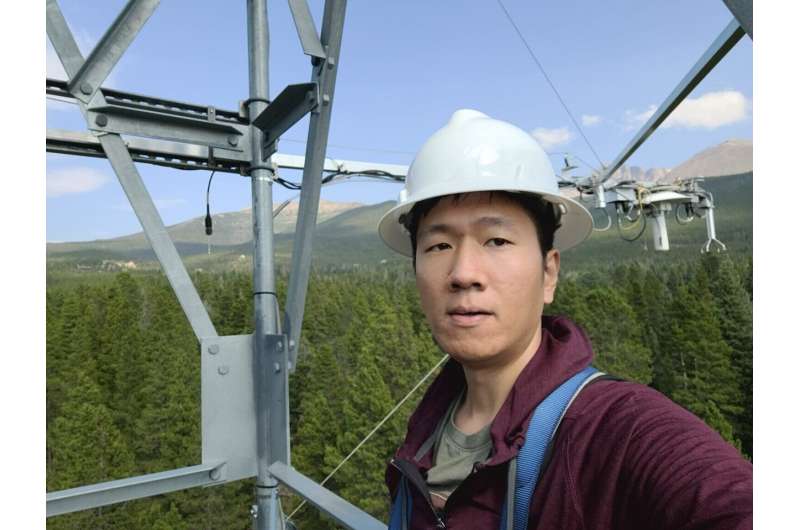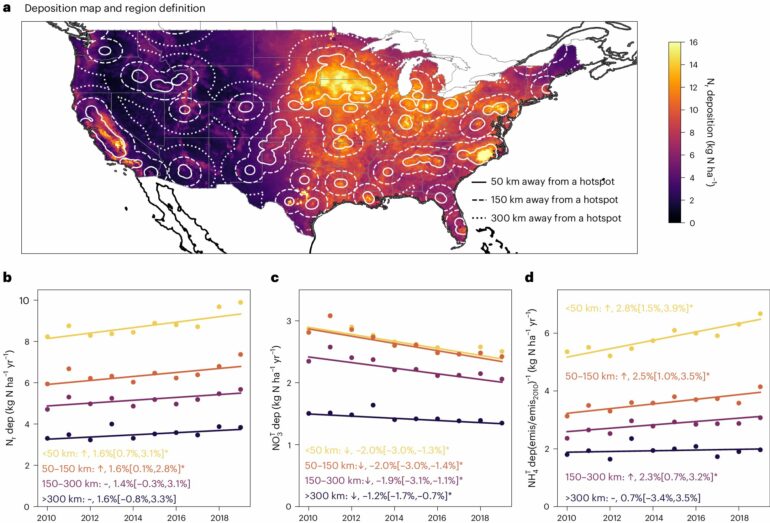The U.S. has slashed smog-causing pollutants like airborne sulfur dioxide in the past 20 years, but the cuts have unintentionally increased ground and water pollution in some local areas, according to research from Princeton and Colorado State University.
In an article, titled “Regime shift in secondary inorganic aerosol formation and nitrogen deposition in the rural United States,” published June 20 in Nature Geoscience, researchers found that decreased atmospheric levels of sulfur dioxide and a group of nitrogen oxide pollutants called NOx (including NO and NO2) have led to increased nitrogen deposits in forests and streams in various parts of the country.
These increased deposits, linked to environmental problems, are found in areas connected to high levels of ammonia emissions, which are generally from agriculture and have not been directly regulated in the U.S.
Researcher Da Pan, who performed the work as a doctoral student at Princeton, said ammonia gas reacts with gases including sulfur dioxide and NOx to form small particles that contribute to smog. With less sulfur dioxide and NOx in the atmosphere, more ammonia remains as gas. The ammonia gas, which contains a lot of nitrogen, returns to the surface and increases the nitrogen deposits on the ground and in water near emission sources.
“A larger fraction of ammonia remains in the gas phase, which deposits rapidly, rather than reacting with sulfur dioxide and NOx to form small particles that deposit relatively slowly,” said Pan, who was recently appointed as an assistant professor at the Georgia Institute of Technology.
Sulfur dioxide and NOx compounds are mainly produced by coal power plants and cars, Pan said. These chemicals react with gases in the atmosphere to form tiny particles that are dangerous for people’s health. An important step in the pollutants changing from gas to solid particles is the reaction with ammonia, a chemical that is emitted from fertilizer use and from livestock waste.
“The formation of particulate matter is like mixing these chemicals in a bucket,” said Pan, who performed part of the work as a post-doctoral researcher at Colorado State University. “The quantity of particles is determined by the chemical present in lowest concentration in the bucket.”
As coal plants closed and auto emissions standards tightened, the amount of sulfur dioxide and NOx in the atmospheric bucket decreased. The researchers said sulfur dioxide emissions dropped 70% and NOx dropped 50% between 2011 and 2020.
While that was good for reducing various forms of air pollution, near agricultural regions it meant that a lot of ammonia eventually settled back to the ground. Also, the ammonia that did stay in the air could be transported further—toward downwind cities.
Deposits of ammonia, which is made of nitrogen and hydrogen, can have several environmental effects, Pan said. Increased nitrogen changes ecosystems by helping some plants grow more and harming others. High nitrogen levels also cause rapid algae growth in lakes and streams. This growth, called eutrophication, can kill fish and other marine life.

Da Pan performed the research while a graduate student at Princeton. © Da Pan
Pan said that the research team drew its conclusions through direct observations of chemical concentrations in the atmosphere from a network of sensors operated by the government and private organizations. For example, as part of the NASA Health and Air Quality Applied Sciences team, the researchers used satellite measurements of ammonia that can locate the largest sources of ammonia emissions and help to interpret the resulting deposition patterns.
This approach differs from work that relies on mathematical models, called atmospheric chemical transport models, to predict how chemicals react and move in the atmosphere.
“Emissions of ammonia are poorly known, which limits the confidence of past chemical transport model results,” said Mark Zondlo, a principal researcher on the project and professor of civil and environmental engineering at Princeton.
“The novelty of this work is constraining particle formation through a suite of direct observations, and the results show the benefits of using observations to identify key pollutants to improve air quality and decrease nitrogen deposition on seasonal and regional scales.”
The researchers used aerosol composition and ammonia concentration observations from 68 locations around the country, primarily in rural areas, as well as national deposition estimates and satellite observations.
They found increased ammonia deposits in areas near high levels of ammonia emissions. Pan said the observation data was noticeably different than levels predicted by simulations based on chemical transport models. He said there are still high levels of uncertainty in the amount of pollutants released to the air and the mechanism behind particle formation in the atmosphere.
Pan said that aerosol composition, ammonia concentrations, and nitrogen deposition data were generally available for rural regions in the U.S. and cautioned that urban areas might have different results and more observations are needed. He also said that some data was impacted by increasing wildfires, particularly in the western U.S.
“Going forward, increasing renewable power generation and electric vehicle use will further decrease emissions of sulfur dioxide and NOx,” said co-principal investigator Denise Mauzerall, the William S. Tod Professor of Civil and Environmental Engineering and Public and International Affairs at Princeton.
“However, reductions in sulfur dioxide and NOx have led to a greater fraction of ammonia emissions being deposited onto sensitive ecosystems near emission sources. Thus, to protect these ecosystems and reduce eutrophication resulting from excess nitrogen, future ammonia mitigation is warranted.”
More information:
Da Pan et al, Regime shift in secondary inorganic aerosol formation and nitrogen deposition in the rural United States, Nature Geoscience (2024). DOI: 10.1038/s41561-024-01455-9
Provided by
Princeton University
Citation:
Cuts in air pollution increased pollution at ground level, research reveals (2024, August 23)



